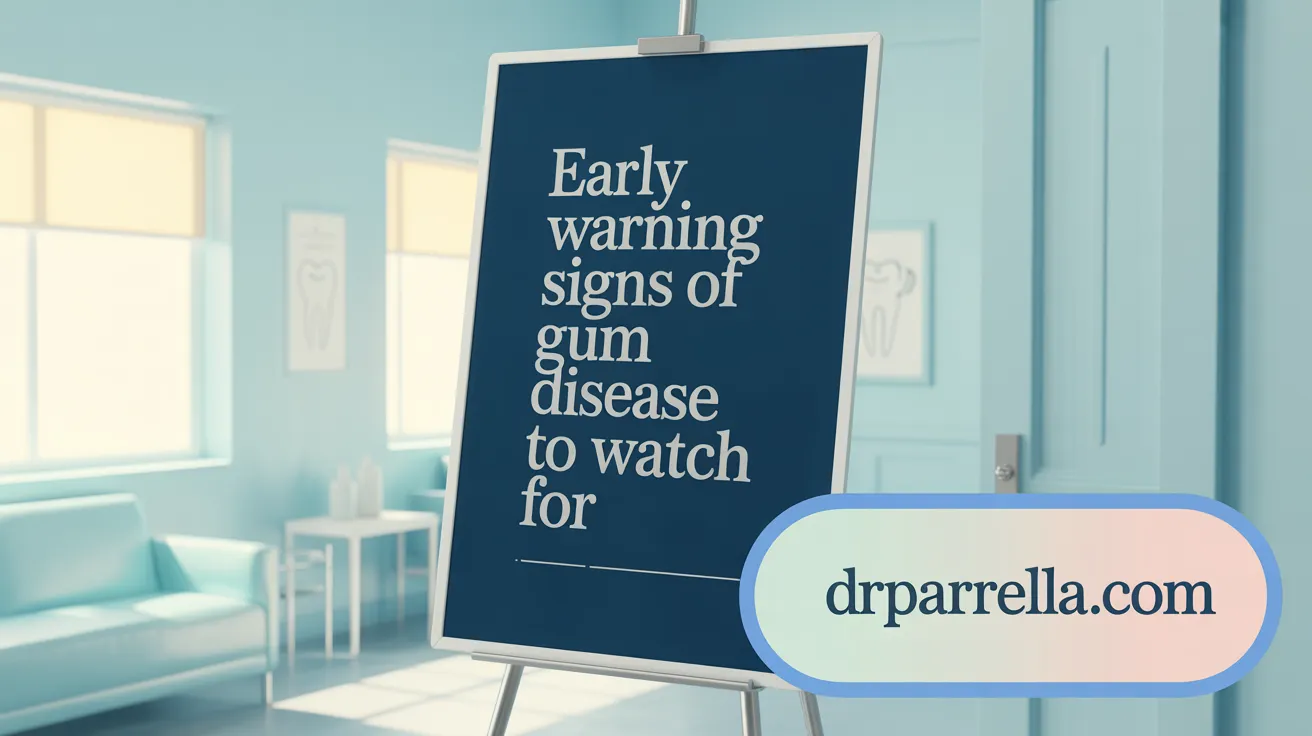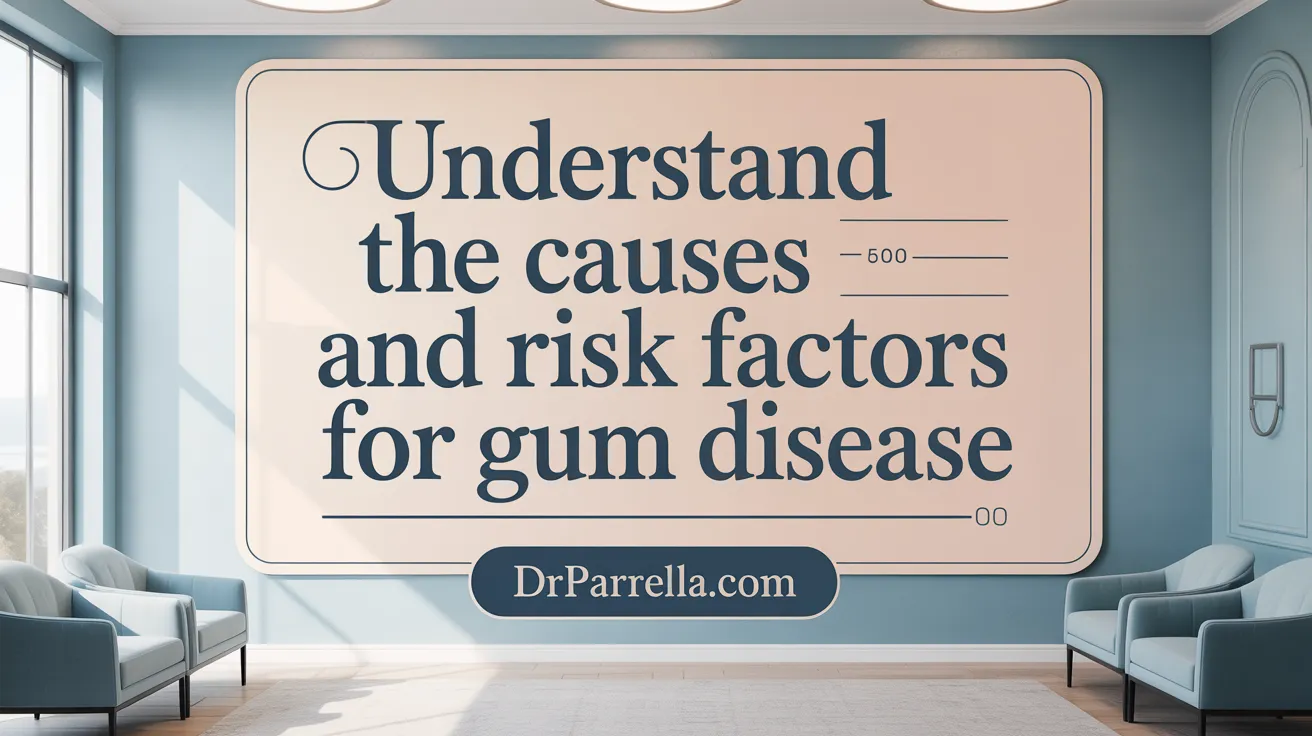Understanding the Importance of Gum Health
Gum disease, often undetected in its early stages, affects nearly half of all adults in the United States. The condition begins subtly, frequently without pain, making awareness of initial warning signs crucial for preventing irreversible damage. Recognizing changes in gum appearance and sensations, along with maintaining good oral hygiene, can safeguard against progression to more severe disease stages that threaten teeth and overall health.
Identifying Early Symptoms of Gum Disease

What are the earliest signs that indicate gum disease?
Bleeding gums during brushing or flossing often mark the initial sign of gum disease, signaling inflammation commonly known as gingivitis. Alongside bleeding, gums that appear red, swollen, or tender to the touch indicate irritation caused by bacterial infection along the gumline. Persistent bad breath and an unpleasant taste are also early warnings, as bacteria in plaque produce these symptoms despite regular oral hygiene. Increased sensitivity to hot or cold foods or drinks near the gumline can signal the exposure of tooth roots due to gum problems.
How does gum recession relate to gum disease?
Gum recession occurs when gums begin to pull away from the teeth, exposing more of each tooth or its root. This symptom is a critical indicator of advancing gum disease. It leads to increased tooth sensitivity, especially to temperature changes, and elevates the risk of tooth decay. Additionally, gum recession exposes vulnerable areas to bacteria, accelerating infection and potential irreversible damage unless addressed promptly (Signs of periodontal disease).
Additional Signs to Watch For
- Red, Swollen, or Tender Gums: Healthy gums are firm and pink; any deviation may warrant dental evaluation.
- Persistent Bad Breath: Unlike temporary halitosis, steady bad breath despite oral care often points to bacterial infection.
- Bleeding Gums: Should never be ignored even if occasional, as it reflects underlying inflammation.
Recognizing these symptoms early enables timely treatment to reverse initial damage and prevent progression to advanced gum disease.
The Stages and Progression of Gum Disease

Gingivitis as the Initial, Reversible Stage
Gingivitis marks the beginning of gum disease. It is characterized by inflammation of the gums, which become red, swollen, and bleed easily during brushing or flossing. This stage is caused by the buildup of bacterial plaque along the gumline. Fortunately, gingivitis is typically reversible with good oral hygiene, including regular brushing, flossing, and professional dental cleanings.
Progression to Periodontitis with Bone and Tissue Damage
If gingivitis remains untreated, the condition can progress to periodontitis, a more severe form of gum disease. In periodontitis, the infection spreads below the gumline, causing the gums and bone supporting the teeth to pull away and form pockets that trap bacteria. This leads to destruction of both soft tissue and bone, resulting in tooth looseness and eventually tooth loss.
Signs Distinguishing Gingivitis from Advanced Gum Disease
While gingivitis presents with bleeding, redness, and swelling of the gums, advanced gum disease shows additional signs such as gum recession making teeth appear longer, persistent bad breath, sensitivity due to exposed roots, loose or shifting teeth, and changes in bite alignment. These symptoms signal damage beyond inflammation, indicating tissue and bone loss.
Consequences of Untreated Gum Disease
Ignoring early symptoms can result in serious complications including permanent loss of teeth, deterioration of the jawbone, and increased risks for systemic health issues like heart disease and diabetes. Early detection and treatment significantly improve outcomes, helping to maintain both oral and overall health.
What happens as gum disease progresses from gingivitis to periodontitis?
Gingivitis is the earliest stage characterized by inflammation and bleeding gums and is typically reversible with proper care. If untreated, it advances to periodontitis, wherein the gums and supporting bone pull away from the teeth, forming pockets of infection, potentially leading to tissue and bone loss, loose teeth, and even tooth loss.
Risk Factors and Causes of Gum Disease

What are the main causes and risk factors for gum disease?
Gum disease primarily originates from the buildup of dental plaque, a sticky film of bacteria that forms on teeth along the gumline. When plaque is not regularly removed by brushing and flossing, it can harden into tartar, which further aggravates the gums and leads to infection. This bacterial activity causes inflammation and destruction of gum tissue and, in advanced stages, the bone supporting the teeth. Learn more about Periodontal disease overview.
Poor oral hygiene is a significant contributor as it allows plaque and tartar to accumulate unchecked. Individuals who do not consistently brush twice daily, floss, and visit the dentist for professional cleanings are at higher risk. For tips, see Oral hygiene tips to prevent gum disease.
Several other factors increase susceptibility or severity of gum disease:
- Smoking: Tobacco use reduces blood flow to gums, suppresses immune response, and impairs healing, heightening the risk and severity of gum infection. More details on Impact of smoking on gums.
- Diabetes: High blood sugar can worsen gum infection and interfere with the body's ability to fight bacteria. See Gum disease and diabetes.
- Hormonal changes: Fluctuations during pregnancy, puberty, or menopause can make gums more sensitive and vulnerable. Read about Hormonal changes affecting gums.
- Genetics: Family history can predispose individuals to gum disease regardless of oral care habits. Learn Genetics in gum disease.
- Medications and systemic conditions: Certain drugs cause dry mouth, reducing saliva that normally protects teeth; autoimmune diseases and stress likewise impact gum health. More on Effects of medicines on saliva flow and Autoimmune diseases and gums.
Additionally, the bacteria causing gum disease can be transmitted through saliva during close contact activities like kissing, emphasizing the contagious potential of these pathogens. See Transmission of gum disease bacteria.
Effective control of gum disease involves addressing these risk factors along with meticulous daily oral hygiene and routine dental visits to remove plaque and tartar buildup. For comprehensive information, visit Preventing periodontal disease.
When to Seek Professional Dental Care

What symptoms indicate the need to see a dentist or periodontist?
Persistent symptoms such as bleeding gums during brushing or flossing, red or swollen gums lasting more than a few days, and bad breath that does not improve with regular hygiene practices are clear warning signs. Additionally, gum recession that makes teeth appear longer, increased sensitivity to hot or cold, loose or shifting teeth, and changes in bite alignment should prompt immediate professional evaluation. Early consultation with a dental professional is crucial to prevent progression of gum disease and avoid serious complications like tooth loss. For more on symptoms indicating when to see a periodontist, see that resource.
How do dental professionals diagnose gum disease?
Diagnosis involves a thorough clinical examination where a dentist or periodontist uses a periodontal probe to measure the depth of gum pockets around each tooth. Excessively deep pockets often indicate gum infection and tissue destruction. Dental X-rays are also taken to assess the level of bone supporting the teeth. Together, these tools help identify the stage and severity of gum disease, guiding the clinician to recommend an effective treatment plan. Learn more about diagnosing periodontal disease and diagnosis of periodontal disease.
Why are regular dental checkups important for early detection?
Regular dental visits allow for early identification of subtle signs that patients might overlook, such as slight redness, swelling, or initial bleeding of the gums. These routine examinations facilitate timely professional cleanings to remove plaque and tartar buildup that cannot be addressed by home care alone. Early detection significantly increases the chances of reversing gingivitis and effectively managing periodontitis. Maintaining oral hygiene and professional dental cleanings and importance of regular dental checkups are key to prevention.
What is the role of a periodontist in managing gum disease?
A periodontist is a dental specialist trained to manage complex gum diseases and their complications. They provide advanced treatments beyond routine cleanings, including scaling and root planing, pocket reduction surgery, bone grafting, and gum grafting. Periodontists also handle dental implant placements and regenerative therapies. For patients experiencing persistent or advanced gum disease symptoms, seeing a periodontist ensures specialized care aimed at preserving dental health and preventing tooth loss. Additional details on signs you need to see a periodontist and periodontist treatments are also helpful.
Preventing Gum Disease and Maintaining Healthy Gums

How can individuals prevent gum disease?
Preventing gum disease starts with consistent daily oral care. Brushing teeth twice daily using fluoride toothpaste effectively removes plaque, the sticky film of bacteria that causes gum inflammation.
Daily flossing complements brushing by cleaning plaque and food particles between teeth and below the gumline, areas a toothbrush can't reach.
Using an antibacterial mouthwash can help reduce bacteria further, promoting healthier gums and fresher breath.
Regular professional dental cleanings and exams are essential. Dentists remove tartar buildup that at-home care can't eliminate and detect early signs of gum disease before it advances.
Managing systemic health conditions, especially diabetes, is important because such conditions can worsen gum health.
A balanced diet rich in vitamins, particularly vitamin C, supports the immune system and aids gum tissue repair. Lifestyle choices such as limiting sugar intake and reducing stress also contribute positively to gum health.
By combining these practices, individuals can effectively prevent gum inflammation and disease, maintaining firm, pink gums that fit snugly around teeth, thus supporting overall oral and systemic health.
Treatment Options for Gum Disease at Different Stages

What treatment options are available for gum disease depending on its severity?
Gum disease treatment varies significantly depending on the stage of the condition. In its earliest stage, known as gingivitis, the disease is reversible. This stage is typically managed by professional dental cleaning to remove plaque and tartar combined with improved daily oral hygiene practices such as regular brushing, flossing, and use of antimicrobial mouthwash. Early intervention at this stage can prevent progression to more severe disease.
For moderate gum disease, or periodontitis, the treatment usually involves scaling and root planing. This deeper cleaning technique removes bacterial plaque and hardened tartar from beneath the gumline, smoothing root surfaces to promote healing and prevent further bacterial colonization.
Advanced gum disease requires more complex treatments. These can include surgical procedures such as flap surgery to reduce periodontal pockets, bone grafting and gum grafting to repair damaged bone and soft tissue, and guided tissue regeneration to encourage the growth of lost bone and tissue. Additionally, platelet-rich fibrin (PRF) and platelet-rich plasma (PRP) therapies may be used to enhance healing.
Early diagnosis and treatment play a crucial role in effective management of gum disease. Timely care improves outcomes, prevents irreversible damage, and reduces the risk of tooth loss. Regular dental checkups are essential to detect early symptoms and initiate appropriate therapies promptly.
Take Action Early to Protect Your Smile
Gum disease is a common yet often overlooked condition that can silently progress from reversible gingivitis to destructive periodontitis, threatening not only oral health but overall wellness. Being alert to early signs such as bleeding, swelling, bad breath, or gum recession empowers you to seek timely dental care. Combining diligent daily oral hygiene with regular professional checkups forms the foundation of prevention and early intervention. With appropriate treatment and lifestyle adjustments, it is possible to maintain healthy gums and preserve your natural teeth for a lifetime.
